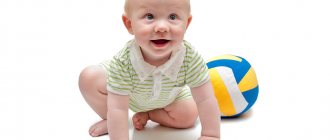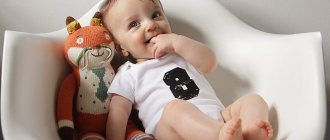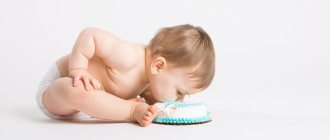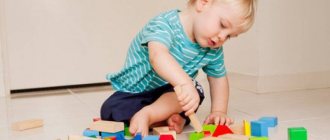The life of many young mothers is like an all-around championship. They strive to prepare the healthiest food for their children, buy them quality clothes, and pay great attention to educational games and activities. And if suddenly a neighbor’s child starts using the potty a month earlier than her own, the woman perceives this as a personal defeat. Although often the age of the baby still allows us not to make a tragedy out of it. Today we will talk about what a healthy boy 10 months old should really be able to do, and what skills can be taught later.
In this article we do not touch upon girls, since the development of children depends not only on how much attention is spent on activities. A lot is determined by what gender they were lucky enough to be born with. Girls tend to be more diligent and observant, so they start talking and using the potty earlier. Future men are impatient. They are easy to interest, but keeping them interested in something for a long time is often difficult. The boys explore everything, but little by little. And that's quite normal.
Most kids are tireless explorers
Where do they get so much energy? Babies continue to learn to crawl and expand their knowledge of the world around them. Muscle tone improves, the child’s movements become even more coordinated.
Some babies crawl forward and around their axis, like seals, on their stomachs.
Others begin to crawl “on all fours,” leaning on their hands and knees. Both methods of movement allow the baby to independently, without the help of an adult, move from one room to another, and overcome various obstacles (thresholds, objects).
Held by the hands, the child stands well on even soles, bearing the entire weight of the body on his feet. Feeling support, the baby learns to lift his leg. The first steps are just around the corner.
https://youtu.be/H14x4bgJKfo
In a sitting position, the baby feels very confident - he maintains his balance well, even if he holds objects in his hands. Be very careful, do not leave your baby unattended if he is sitting on the sofa or in an armchair.
Confidence in his own abilities pushes the baby to master new movements - he learns to get off and climb on the sofa, climb stairs. These motor skills allow the child to look at surrounding objects from a new perspective, at different distances.
Physical development of a child at 10 months
Physical development is progressing more and more. Since a 10-month-old baby's day becomes more active, he does not gain weight as quickly as before. The norm is considered to be a weight gain of 400-500 g per month. The normal height increase per month is 1.5-2 cm, the head circumference in boys and girls is about 46.5 cm.
Most children already crawl well and are actively trying to master walking. At this time, the main thing is to develop balance and orientation in space. There are children who by this time cannot pull themselves up and stand on their own legs. The time has come to encourage and facilitate this in every possible way. This can be done by placing any toy or new object that interests the baby on a low sofa or chair and helping the child get up. By retrieving objects, he trains spatial orientation. By this period, the baby has good command of the movements of the shoulder, forearm, wrist and fingers, and without difficulty takes small objects with his fingers and examines them.
But it is worth remembering that each child is individual. The physical development of a child occurs differently for everyone. Some people don’t crawl, but immediately start walking. Some people have normal height, others don't. And someone does everything one by one: crawls, then learns to walk with and without support.
At 10 months, the child can independently stand on his feet in the crib, and sit down from a standing position. The time has come to set up a new playing place, since previously a playpen or a small rug was enough for playing. A low sofa is best. After all, any child easily masters the sofa: he either gets off or climbs on it - such a home attraction allows him to develop. The parents' task is to provide insurance for the baby to avoid unpleasant falls, by putting, for example, a soft blanket or a lot of plush toys.
By ten months, a favorite type of activity will have formed. Some move with joy when they hear music, some build towers from figures, and some look at pictures in books and magazines.
Mental development of a child at 10 months
This month the baby will surprise you with unexpected and long-awaited actions. He will bite the tip of his tongue and try to repeat his dad's antics. He will devote more time to clearing out the contents of the lower cabinets and shelves that he can reach. Will persistently touch a laptop, tablet, phone and other prohibited achievements of modern science. Since the child usually does not walk independently at this time, it is important for him to move more, strengthen his muscles, and prepare his body for upright walking. Although already in the tenth month the child is standing, holding onto support, and even stomping a little, it is better for him to still crawl.
At 10 months, the baby is not afraid to go into the arms of strangers. During this period, interest in peers awakens, but they will not play together yet. The child may already know the names of some objects and the names of people, and repeat sounds and syllables after adults. By this time, the little one is already confidently holding two toys in his hands.
From this time on, the personality of the little person begins to form; the actions of the parents have a great influence on this. The child repeats everything after the adults. By imitation, he learns to feed the stuffed bunny with carrots. The baby remembers the words “impossible” and “no”; moreover, sometimes he can pronounce and show these words. The baby's memory becomes more voluminous. He can reproduce an action he saw about a week ago and remembers where his toys are.
The child imitates the sounds that adults pronounce, changing the intonation and volume of his voice. Plays with his tongue and saliva, making funny noise, and laughs at his pranks. In his own language, he can name any things or actions, they are often incomprehensible. Parents should continue to talk to the child as an adult; it is useful for him to read fairy tales.
Since this small anniversary, “naughtiness” has been increasing very rapidly. And this should not be attributed to character traits, it is simple curiosity and knowledge of an as yet unknown world for the baby. And don’t be upset if you find cubes in the pan, and part of the pyramid in the toilet. After all, the parents’ dissatisfaction either very upsets the baby or provokes him. There is no need to punish either, you can get him to start being cunning and continue to do things his own way, but behind mom and dad’s back. The main thing in this case is to switch attention and provide the child with safe and no less interesting areas of the apartment for “exploration”.
Games for kids
The games of a 10-month-old child become more focused. He holds the toy tightly, performs various tasks: takes and gives a cube, opens and closes boxes while sitting on the floor, rolls and throws a ball. Therefore, you should choose games that match the specified skills. Disassembling and assembling is the most exciting activity for a baby right now. This could be unloading and loading a train, filling a container with geometric shapes, etc. The modern market for such games is captivating with the breadth of choice.
One of the most useful toys at this stage is the pyramid. With mother's help, the child collects it and, rejoicing at the result, waits for encouragement. Place a container on the floor and offer to throw various objects into it, especially those that make some kind of sound when hit. Let's throw small toys with different hands, and large ones with two, change the distance of the box, place it closer, then further. In this way, the baby’s ability to manipulate objects develops.
It's time to offer finger paints. The delight will be indescribable! When choosing a tiny color, call it. This way he will quickly learn the basic colors, understand them and pronounce their names.
From 10 months, a child absorbs information like a sponge. Cognition games are appropriate and highly desirable. Place your baby in a comfortable position, on a sofa, high chair, or in your arms. If he is inclined to communicate, introduce him to animals. There are probably toys and pictures in the house in the form of animals and fruits. You need to place them in front of the child and show them one by one, pronouncing the sound that corresponds to one or another animal. Let the child repeat it.
No games, modern, colorful and super educational, can replace playing outside. After all, they have a beneficial effect on the baby’s development and are very beneficial for his health.
Nursery rhymes and simple poems that accompany waking up and getting dressed do not lose their relevance. Let your child look at books. Nowadays, books with thick cardboard pages are suitable, on which fruits, vegetables, and animals are depicted. This is very interesting for children. By turning the pages, he develops motor skills, looking at pictures, he learns about the world.
Caring for a 10 month old baby
A 10-month-old child has changes in care. But hygiene remains unchanged. Perform morning routines: washing your face, cleaning your nose and ears - in a playful manner.
Night sleep lasts 10-12 hours. Daytime sleep can be from 2 to 3 hours, sometimes in two sessions, although it often happens that the child sleeps once. It is necessary to ensure that the baby rests in a calm environment during the lunch period so that he does not become overexcited and does not become capricious because of this.
It is useful to spend more time outdoors, dressing your baby according to the weather so that he does not get too hot, but hypothermia should not be allowed.
Children already at this age are sitting and can carry out movements without fear and quickly assimilate information. Everything contributes to potty training.
Lead by example. When putting away toys, ask your child to help you, putting some things away, choosing a book - also ask for help. He will carry out instructions, taking them for a game, and actively take part in those that he likes best. Thus, while accustoming the child to doing things together, we teach him to follow a daily routine and prepare for lunch and a walk, for example.
https://www.youtube.com/watch?v=NwzHrE5WXGU
Mental development
Kids begin to navigate everyday situations, recognize some sounds and correlate them with the sound source - they turn their heads towards the ringing phone or the sound of a door opening slightly, look for familiar objects and people with their eyes if an adult is talking about them.
The baby likes to explore the contents of cabinets, especially kitchen cabinets - he happily takes pots, pans, bowls from there and scatters them on the floor.
These games with household utensils continue for a long time, sometimes up to two years. The child does not yet take the adult’s prohibitions not to touch “dangerous” objects (forks, glassware) seriously. Remember this and try to make the space around the baby safe in advance.
Nutrition and child development according to Komarovsky
A 10-month-old child enjoys gnawing on hard vegetables and fruits, cookies, and crackers. At this time, low-fat varieties of fish are introduced into baby food.
At 10 months, the child tries to feed himself, clumsily moves the spoon in the plate, but can already drink from a cup on his own. You should discard the bottle, as it negatively affects the teeth. At this age, the child continues to eat five meals a day. The first and last feeding is an important component of nutrition. We continue to give breast milk or formula if the baby is bottle-fed. There are children who can still wake up at night to have a snack. Dr. Komarovsky believes that children under one year of age should have a mixture in their diet if breastfeeding is not possible.
Komarovsky advises that the diet of a 10-month-old child should contain kefir (100 g), cottage cheese (no more than 50 g), baked apple (50 g), vegetable puree and milk porridge (120 g), juice (20-30 ml), whole yolk, meat puree (40-50 g), fish puree (5-20 g), cookies (10 g), vegetable oil (3 g). In this case, the cottage cheese should be homemade from cow's milk, the vegetable puree should contain potatoes, carrots, beets, and milk porridge should preferably be buckwheat and rice.
Remember that if the mother is still breastfeeding, then the foods that the parents eat affect the baby’s health and development. Therefore, you should not consume strictly prohibited foods. Take into account that not all newly introduced products in the 10th month can be immediately and well absorbed by the child’s body.
Komarovsky notes the special importance of cleanliness, especially when preparing food for a child. Hands should be washed well and ideally it is better to dry them with a disposable paper towel. Rinse the vegetables well with running water, keep the dishes, cutting board and work surface clean. You still need to cook for one meal and remember that the cooked product can stand for no more than two hours.
Ten months is an interesting period in a child's development. Important points that need to be carefully monitored are the baby’s weight, height and nutrition. If there are no strong deviations from the norm, then the child’s height and weight may change in the next months of the newborn’s life.
Children's games become longer and more varied
“Favorite” soft toys and dolls appear. A child gets angry and shows his dissatisfaction if an object (toy) that he likes is taken away from him. At the request of an adult, children can give a toy and show its details. Children love playing with objects that can be taken out of small boxes, bags, and transparent jars.
Start leaving small cardboard boxes with toys and objects in different places in the apartment that the baby will take out and examine. The baby gets great pleasure from playing with adults. The baby understands the rules of the game and laughs loudly if an adult hides under a scarf or behind furniture.
Remember the traditional Russian nursery rhymes: “Guli-Guli”, “Soroka-Soroka”, “Horned Goat”. The emotional intonation and simple rhythm of the rhyme help the baby remember and perform simple movements that accompany reading the nursery rhyme - he begins to clap his hands, bend his fingers, put his hands on his head. Such games help to remember the meaning of words denoting objects and actions.
Educational games
In his video lessons, Evgeniy Komarovsky always emphasizes that parents should devote enough time to the child, and not hope that he should explore the world and learn everything new on his own. The first year of a baby’s life is considered the foundation for further development. Playing games together is the best way to gain new information.
A ten-month-old child plays enthusiastically; during this period he needs toys of various shapes, colors, purposes and new activities. Games should build on what a child can do at 10 months and provide opportunities for further development.
Coordination games
- Play “Ladushki”, reciting poems or counting rhymes, illustrate the words with movements and characteristic sounds, inviting the child to repeat everything after you.
- Dance in a circle with your baby, perform rhythmic movements, holding him by both hands. Dance to the music with your baby in your arms. You can rock or spin it.
- Invite your child to throw toys of different shapes, weights and sizes into the box from a short distance.
Games for developing fine motor skills
- Transferring fairly small objects, such as beans, pebbles or buttons, from one bucket to another. Supervise your child at this moment so that he does not put it in his mouth!
- Opening and unscrewing lids of different sizes from saucepans, jars, and bottles.
- Playing with solids. Invite your child to rake his palms up the hill or, conversely, scatter cereal on the surface of the table, or spoon semolina or tea from one container to another.
- Playing with snow. Show how to make a snowball; if it doesn’t work, make it yourself and let your child throw it.
- Tearing sheets of paper or unleavened dough into small pieces.
It is advisable that the child use both hands when playing. This will promote the development of both hemispheres of the brain and the connections between them.
Educational games
- Games with pyramids, cubes, nesting dolls or other objects that can first be taken apart and then put back together into one whole.
- Role-playing games: playing on the phone, feeding dolls, driving cars - remain important for acquiring new knowledge.
- Hide and seek games in various variations: from simply covering your eyes with your palms to searching for a toy hidden under a pillow, or for a grandmother in the next room.
- All types of drawing are welcome - pencils, felt-tip pens, crayons, paints with fingers and palms.
If a child is unable to manipulate some objects, use the passive movement method, when an adult controls the child’s hands to complete the task. A few repetitions - and the child will cope on his own.
Babies begin to react to unpleasant situations and harmful objects
But for now, this ability is very individual and manifests itself in different ways, so you shouldn’t particularly count on the “conscious” behavior of the baby. For example, fear of heights. At this age stage, children develop a fear of heights, which is clearly demonstrated by the experiment with a cliff.
Cover the surface of the table with glass, place a bright cloth under it on half the table, and spread another piece of such cloth under the table on the other side. Place the child on the part of the table where the cloth lies, and he will crawl forward. When the baby reaches the edge of this part of the table, his hands continue to rest on the glass, but his eyes “say” that there is an abyss ahead, so the little one stops without crawling to the other half of the table. This experiment proves that babies at this stage of development can determine the edge and height and make a decision: they can’t crawl any further.
Parents should definitely be warned that, despite the described experience and the baby’s reaction, never leave the child to play on the table! In impulsive children, temperament sometimes takes precedence over the awareness of the impending danger, and they may well crawl forward, “over the edge of the abyss.”
Hygiene procedures
To the question “why should you bathe your child every day,” some mothers answer - so that he is clean. However, the goal of water procedures is not only a clean child, but also:
- Active movement and release of accumulated energy;
- Hardening the body;
- Prevention of skin diseases;
- Positive emotions for everyone.
Spending time together and communicating during water procedures helps strengthen the emotional connection with the child not only for mothers, but also for fathers. It is very important that the baby’s dad also participates in bathing. The child needs to see that there is a strong father nearby who loves him.
Watch a video about what you can do to keep your baby busy while bathing:
What is the degree of trust the child has in his mother?
An interesting variant of the cliff experiment is the situation when children boldly crawl forward through a “visible” abyss if their mother is waiting for them at the other end of the table with a calm face that does not express any fears about this situation. If there is fear on the mother’s face, then the child freezes in place. Summary: Mothers are emotional regulators for children.
The child receives information about how to behave by “reading” it from the mother’s face or by grasping the mother’s attitude towards her signals. Children read absolutely everything on our faces, especially what relates directly to them. If you are constantly in a depressed, irritable state, then the expression that your child sees on your face is one he will probably carry with him for the rest of his life. The face illuminated by a smile that your child sees will also be remembered by him for the rest of his life.
Daily routine and sleep time
In children of the first year of life, the daily routine is constantly changing. So, at 10 months a child can switch from 3 to 2 naps. If earlier sleep lasted 40 minutes in the morning and evening, and during the day - 1.5-2 hours, now everything is different.
- Waking up at 6-7 am, the duration of wakefulness will last until 10-10:30 pm. At this time there will be a second breakfast, and after that a first nap lasting 1.5-2 hours.
- After waking up, the baby plays - you can go for a walk.
- Closer to 14:00 it’s time for lunch, and then you can start exploring the world again.
- At 15:00 – 15:30 it’s time for the second sleep, the duration of which can be up to 2 hours. After sleep, you can repeat the walk.
- You should not put your child to bed later than 22:00.











